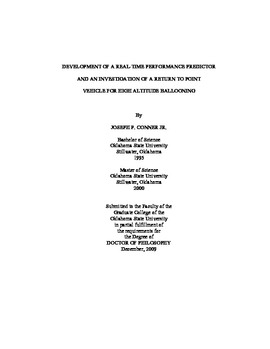| dc.contributor.advisor | Arena, A. S. | |
| dc.contributor.author | Conner, Joseph P., Jr. | |
| dc.date.accessioned | 2013-12-10T18:05:15Z | |
| dc.date.available | 2013-12-10T18:05:15Z | |
| dc.date.issued | 2009-12 | |
| dc.identifier.uri | https://hdl.handle.net/11244/7791 | |
| dc.description.abstract | Scope and Method of Study: The goal of this study was twofold: First, to gain a better understanding of the governing dynamics in near-space missions and to investigate the feasibility of a low cost autonomous parafoil for control during the descent phase. A study of balloon expansion and drag was conducted to investigate the ascent phase of a flight. The next phase of the project created of a custom prediction program used in real-time to accurately predict the landing location of payloads well before they actually landed. The program was designed to detect and adjust the major dynamic parameters as seen during the flight, and then to use this information to increase the accuracy of predictions. The second goal of this project was to determine the feasibility of using a low cost autonomous parafoil to increase the control over a desired landing zone. This study was conducted in two phases: The first phase tested the autopilot on a ground vehicle to gain confidence in the system. The second phase tested autopilot on an actual parafoil. | |
| dc.description.abstract | Findings and Conclusions: The major findings for this project are: An increase in understanding of the balloon dynamics in the ascent phase was required in order to correctly predict the reaction of the system. In the process of gaining this understanding, two major items were found: First, near-space balloons can be modeled as zero-pressure balloons and thus their expansion is governed by the Ideal Gas Law. Second, the assumed drag model for near-space missions in the size range of 10 to 20 lbs. and 600 cu ft. of Helium was grossly misunderstood. While the system does transition from a high to low drag coefficient, it does so at a much slower rate than that a classical sphere. The method of detecting and correcting parameters in real-time lead to a major increase in accuracy in the predicted landing zone just after burst. Typically, the system has an accuracy of 2 miles or better, two minutes after burst has occurred. The second part of this study determined that it is feasible to utilize a low cost autonomous parafoil to increase control during the descent phase. The parafoil allows the system to reach a designated landing zone instead of landing at the whim of the winds. | |
| dc.format | application/pdf | |
| dc.format | application/zip | |
| dc.language | en_US | |
| dc.rights | Copyright is held by the author who has granted the Oklahoma State University Library the non-exclusive right to share this material in its institutional repository. Contact Digital Library Services at lib-dls@okstate.edu or 405-744-9161 for the permission policy on the use, reproduction or distribution of this material. | |
| dc.title | Development of a real-time performance predictor and an investigation of a Return to Point Vehicle for high altitude ballooning | |
| dc.contributor.committeeMember | Jacob, J. | |
| dc.contributor.committeeMember | Young, G. | |
| dc.contributor.committeeMember | DeYong, C. | |
| osu.filename | Conner_okstate_0664D_10663.pdf | |
| osu.accesstype | Open Access | |
| dc.type.genre | Dissertation | |
| dc.type.material | Text | |
| dc.subject.keywords | balloon dynamics | |
| dc.subject.keywords | high altitude ballooning | |
| dc.subject.keywords | near space | |
| thesis.degree.discipline | Mechanical and Aerospace Engineering | |
| thesis.degree.grantor | Oklahoma State University | |
